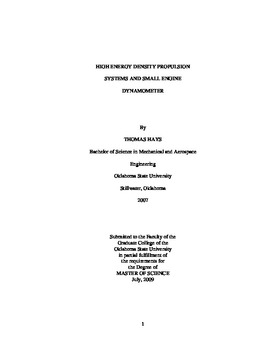| dc.contributor.advisor | Arena, Andrew S. | |
| dc.contributor.author | Hays, Thomas | |
| dc.date.accessioned | 2014-04-17T19:52:30Z | |
| dc.date.available | 2014-04-17T19:52:30Z | |
| dc.date.issued | 2009-07-01 | |
| dc.identifier.uri | https://hdl.handle.net/11244/9944 | |
| dc.description.abstract | This study investigates all possible methods of powering small unmanned vehicles, provides reasoning for the propulsion system down select, and covers in detail the design and production of a dynamometer to confirm theoretical energy density calculations for small engines. Initial energy density calculations are based upon manufacturer data, pressure vessel theory, and ideal thermodynamic cycle efficiencies. Engine tests are conducted with a braking type dynamometer for constant load energy density tests, and show true energy densities in excess of 1400 WH/lb of fuel. Theory predicts lithium polymer, the present unmanned system energy storage device of choice, to have much lower energy densities than other conversion energy sources. Small engines designed for efficiency, instead of maximum power, would provide the most advantageous method for powering small unmanned vehicles because these engines have widely variable power output, loss of mass during flight, and generate rotational power directly. Theoretical predictions for the energy density of small engines has been verified through testing. Tested values up to 1400 WH/lb can be seen under proper operating conditions. The implementation of such a high energy density system will require a significant amount of follow-on design work to enable the engines to tolerate the higher temperatures of lean operation. Suggestions are proposed to enable a reliable, small -engine propulsion system in future work. Performance calculations show that a mature system is capable of month long flight times, and unrefueled circumnavigation of the globe. | |
| dc.format | application/pdf | |
| dc.language | en_US | |
| dc.publisher | Oklahoma State University | |
| dc.rights | Copyright is held by the author who has granted the Oklahoma State University Library the non-exclusive right to share this material in its institutional repository. Contact Digital Library Services at lib-dls@okstate.edu or 405-744-9161 for the permission policy on the use, reproduction or distribution of this material. | |
| dc.title | High Energy Density Propulsion Systems and Small Engine Dynamometer | |
| dc.type | text | |
| dc.contributor.committeeMember | Lowery, Richard L. | |
| dc.contributor.committeeMember | Jacob, Jamey D. | |
| osu.filename | Hays_okstate_0664M_10414.pdf | |
| osu.college | Engineering, Architecture, and Technology | |
| osu.accesstype | Open Access | |
| dc.description.department | Mechanical & Aerospace Engineering | |
| dc.type.genre | Thesis | |
